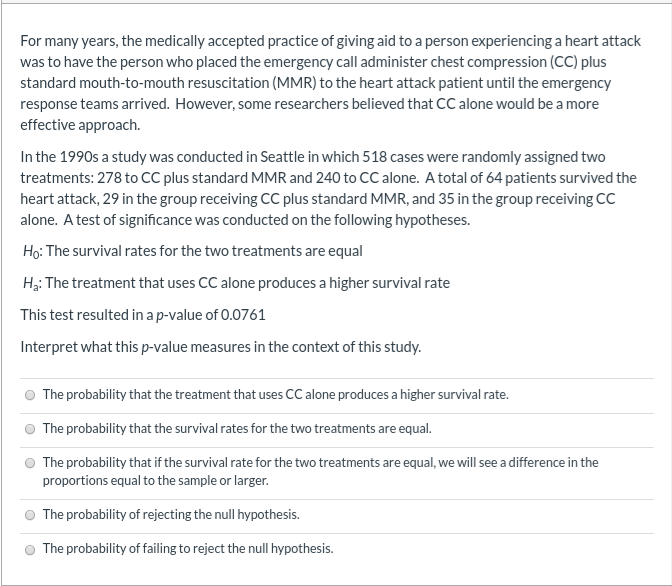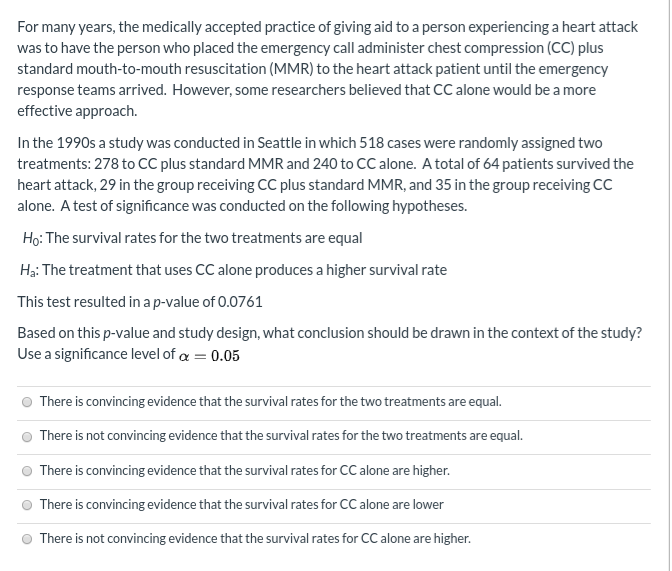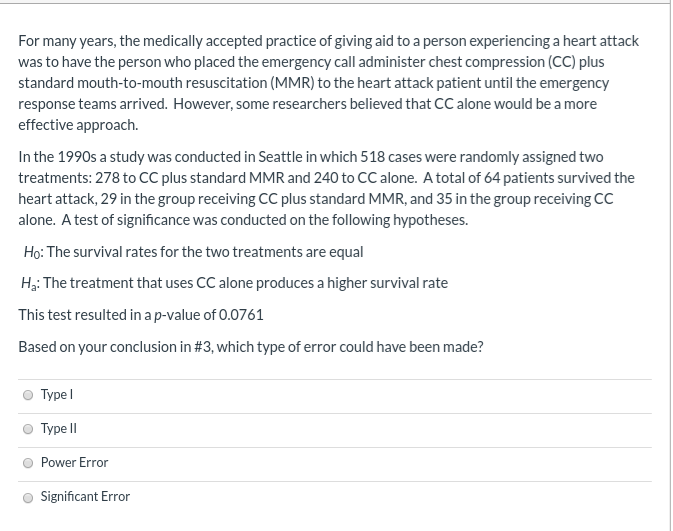help please
For many years, the medically accepted practice of giving aid to a person experiencing a heart attack was to have the person who placed the emergency call administer chest compression (CC) plus standard mouth-to-mouth resuscitation (MMR) to the heart attack patient until the emergency response teams arrived. However, some researchers believed that CC alone would be a more effective approach. In the 1990s a study was conducted in Seattle in which 518 cases were randomly assigned two treatments: 278 to CC plus standard MMR and 240 to CC alone. A total of 64 patients survived the heart attack, 29 in the group receiving CC plus standard MMR, and 35 in the group receiving CC alone. A test of significance was conducted on the following hypotheses. Ho: The survival rates for the two treatments are equal Ha: The treatment that uses CC alone produces a higher survival rate This test resulted in a p-value of 0.0761 Interpret what this p-value measures in the context of this study. The probability that the treatment that uses CC alone produces a higher survival rate. O The probability that the survival rates for the two treatments are equal. The probability that if the survival rate for the two treatments are equal, we will see a difference in the proportions equal to the sample or larger. O The probability of rejecting the null hypothesis. O The probability of failing to reject the null hypothesis.For many years, the medically accepted practice of giving aid to a person experiencing a heart attack was to have the person who placed the emergency call administer chest compression (CC) plus standard mouth-to-mouth resuscitation (MMR) to the heart attack patient until the emergency response teams arrived. However, some researchers believed that CC alone would be a more effective approach. In the 1990s a study was conducted in Seattle in which 518 cases were randomly assigned two treatments: 278 to CC plus standard MMR and 240 to CC alone. A total of 64 patients survived the heart attack, 29 in the group receiving CC plus standard MMR, and 35 in the group receiving CC alone. A test of significance was conducted on the following hypotheses. Ho: The survival rates for the two treatments are equal Ha: The treatment that uses CC alone produces a higher survival rate This test resulted in a p-value of 0.0761 Based on this p-value and study design, what conclusion should be drawn in the context of the study? Use a significance level of a = 0.05 O There is convincing evidence that the survival rates for the two treatments are equal. There is not convincing evidence that the survival rates for the two treatments are equal. O There is convincing evidence that the survival rates for CC alone are higher. There is convincing evidence that the survival rates for CC alone are lower O There is not convincing evidence that the survival rates for CC alone are higher.For many years, the medically accepted practice of giving aid to a person experiencing a heart attack was to have the person who placed the emergency call administer chest compression (CC) plus standard mouth-to-mouth resuscitation (MMR) to the heart attack patient until the emergency response teams arrived. However, some researchers believed that CC alone would be a more effective approach. In the 1990s a study was conducted in Seattle in which 518 cases were randomly assigned two treatments: 278 to CC plus standard MMR and 240 to CC alone. A total of 64 patients survived the heart attack, 29 in the group receiving CC plus standard MMR, and 35 in the group receiving CC alone. A test of significance was conducted on the following hypotheses. Ho: The survival rates for the two treatments are equal Ha: The treatment that uses CC alone produces a higher survival rate This test resulted in a p-value of 0.0761 Based on your conclusion in #3, which type of error could have been made? O Type l O Type II O Power Error Significant Error









